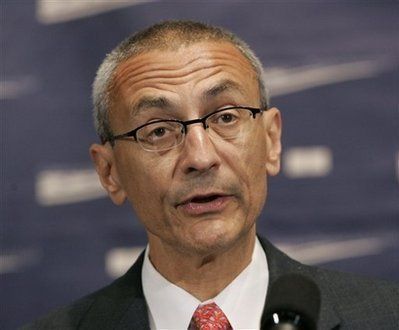
Before it was clear that Barack Obama would be elected, John Podesta, the current co-chair of the White House transition team, laid out an agenda for the next president that was aggressive, assertive but politically practical.
In excerpts of a book being released in January, "Change for America: A Progressive Blueprint For The 44th President," Podesta describes the need for a chief executive that scores quick and decisive victories while exhibiting respect for Congress and some independence from the early demands of political interest groups.
Writing in sometimes ominous terms about a future Democratic government, he emphasizes that the president-elect must move aggressively on his agenda "regardless of the environment," or face a revolt from voters.
"[I]f the president and his administration do not take the time upfront to develop a clear and coherent blueprint for action -- and find ways to move this agenda regardless of the environment -- then they will quickly find the windows of opportunity shutting before their eyes and will face increased public frustration and disappointment," he writes in the book's introduction.
In another portion of the book, Podesta and co-author Sarah Rosen Wartell detail how Obama can -- and should -- hit the ground running.
"Sustaining political capital and momentum for the agenda requires early victories on key issues on which the president campaigned. To achieve early victories, the president needs to take advantage of the power of the executive branch to make change happen on its own. Executive orders, regulatory waivers, reallocation of appropriated program resources, and changes to program policies are routes available in many circumstances to show that change can happen quickly," write Podesta and Wartell.
Such a strategy, the authors note, requires resisting the demands of interest groups for various new legislative packages. Passing such policy through Congress can be a politically taxing task, and would keep the Democratic White House focused on the Republicans' policy priorities.
"With a change of party, some administrations have spent great energy in reversing the regulations and agency policies of the prior administrations. Some reversals will be important to show the change in direction the president wants to achieve, but the demands from interest groups to focus on policy restoration should be resisted. The reason: It lets the president's predecessor and his political party continue to pick the issue around which the debate is held. Administrations are notoriously slow to get their own regulatory agenda into gear. Doing so is one of the best ways to shape the debate quickly, while legislative agendas are developed."
The passages provide some of the clearest indications yet as to how Podesta envisions a future Obama presidency. And as co-chair of his transition effort, he is uniquely situated to determine the layout of the future administration. The former Clinton chief of staff noted early this week that Obama will likely use executive orders to reverse some of the actions taken by the Bush administration. Moreover, the choice of Rahm Emanuel as chief of staff seemingly aligns to the characteristics that Podesta and Wartell say are essential for the job.
"[I]n any model it is the president's best interest for his chief of staff to be a powerful decision maker on both process and substance on issues of significance, within parameters established by, and in service of the goals and strategies of, the president," they write. "The new president should put special emphasis on having a staff with strong Capitol Hill relationships.... Disrespect of Congress' prerogatives can give rise to enormous obstacles to the president's goals, even if public support is mobilized."
In the nine-page chapter, titled "Managing the White House for a Successful Presidency," Podesta and Wartell outline other administrative priorities and diagram the attributes that the next president (in this case, Obama) should take in staffing his administration.
• The chief of staff should hire two deputies: one for policy purposes the other for White House management.
• The president "should have some advisors who were with him on the stump."
• The next White House should "have some individuals with experience gained from working in government agencies, to balance the instinctive desire of White House staff to develop all policy internally."
• The National Security Adviser will serve in one of the most influential - but potentially problematic - posts. The chief of staff must recognize that he or she "has some unique statutory and operational responsibilities that differentiate the role from that of other policy advisors." In other words: the NSA must be kept in the loop without consuming too much of the president's agenda
• The vice president "should be fully integrated into executive branch decision making," and serve as a "principal on all policy councils."
Podesta wrote this chapter as part of a much larger project spearheaded by he and Mark Green, the longtime New York Democrat who helped advise Bill Clinton's 1992 transition. "Change for America: A Progressive Blueprint For The 44th President," was released, in part, on Monday. Over 600 pages and more than 50 sections long, it advises the next president on every major topic facing his administration. Podesta later recused himself from the project when he was tasked by the Obama campaign to help lead his post-election transition efforts.
